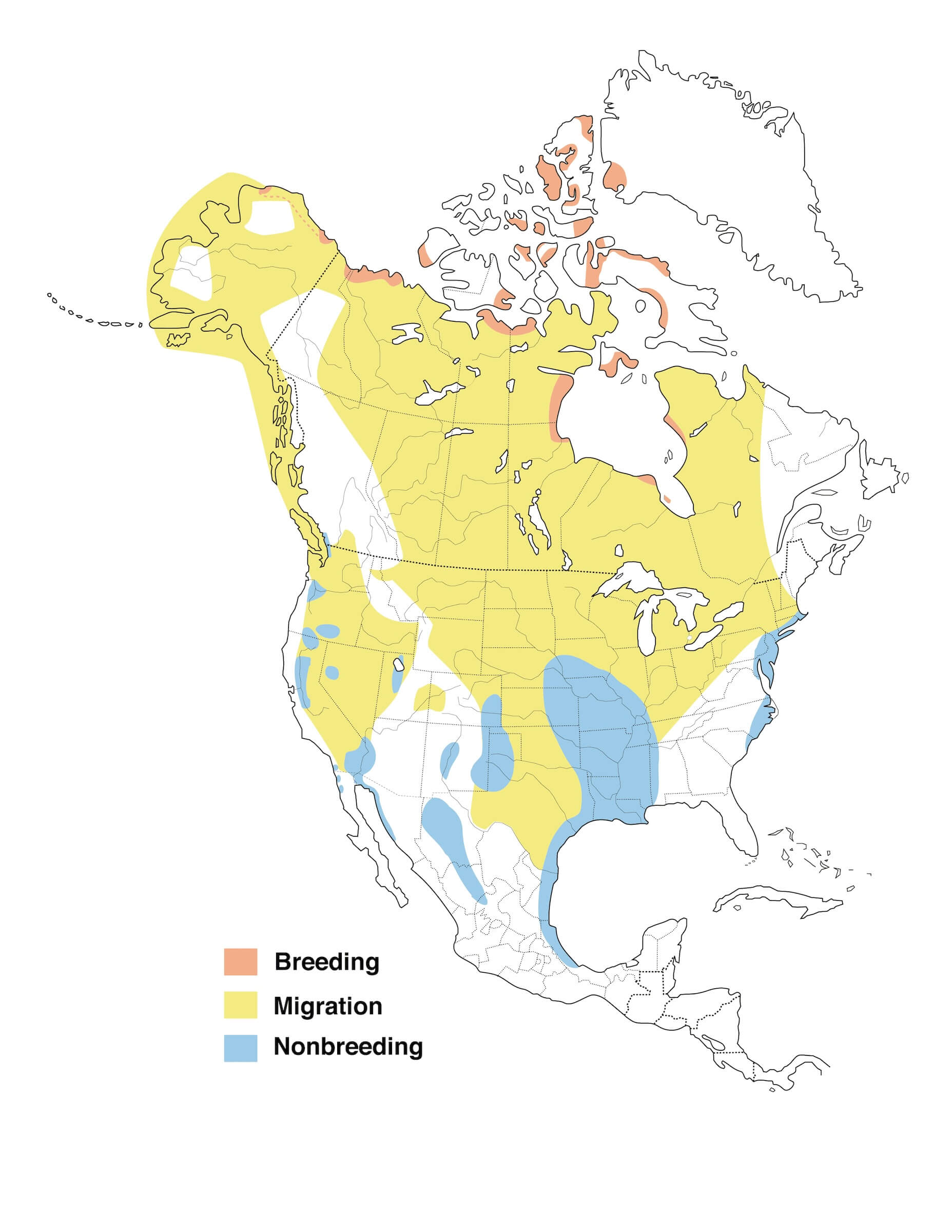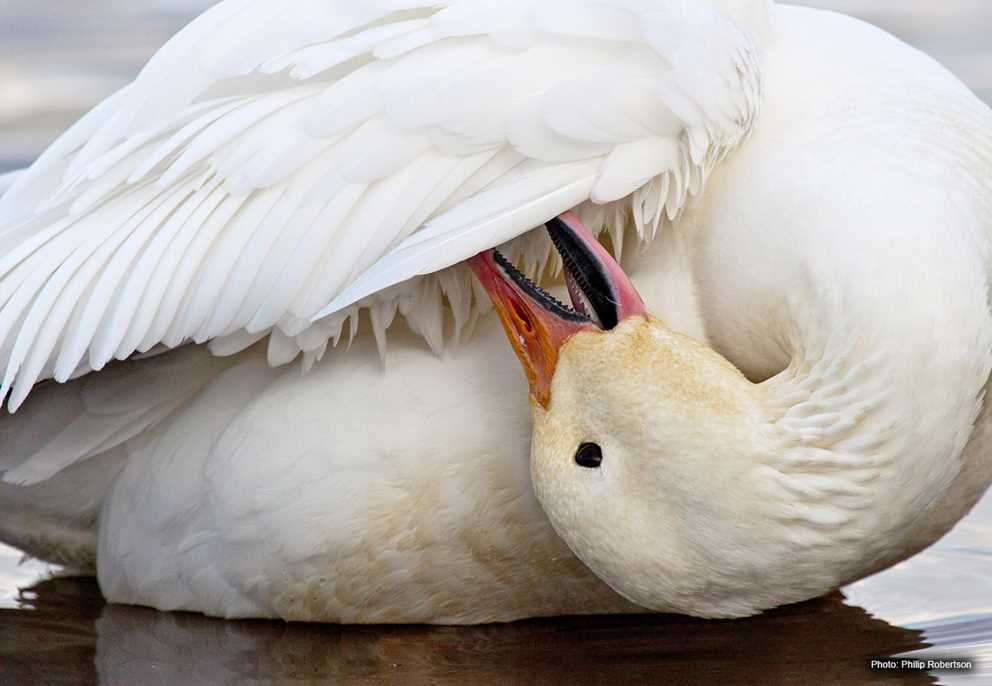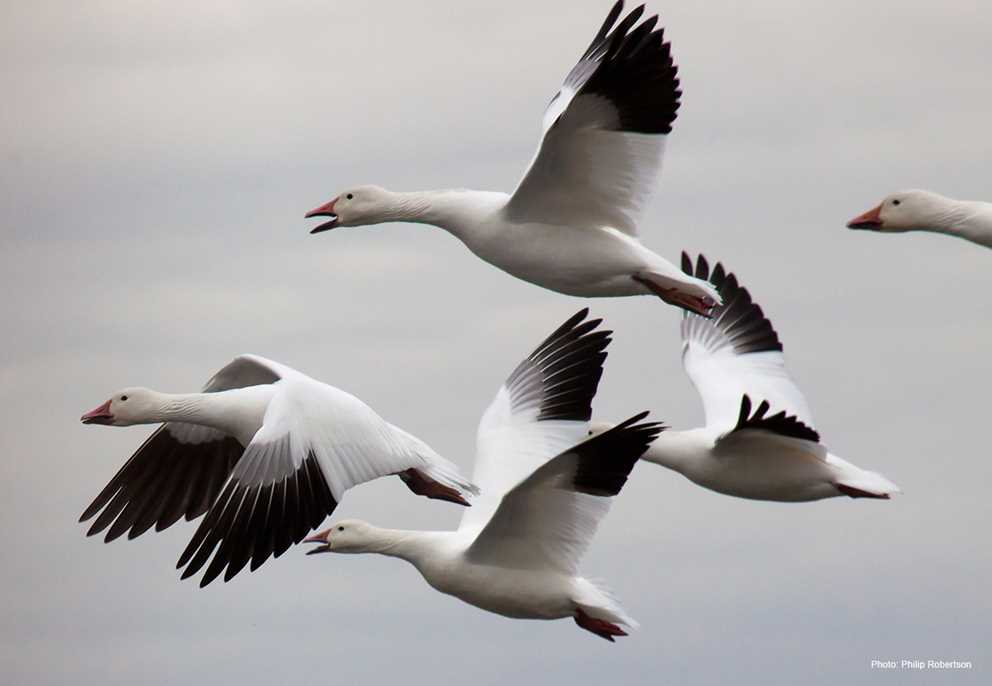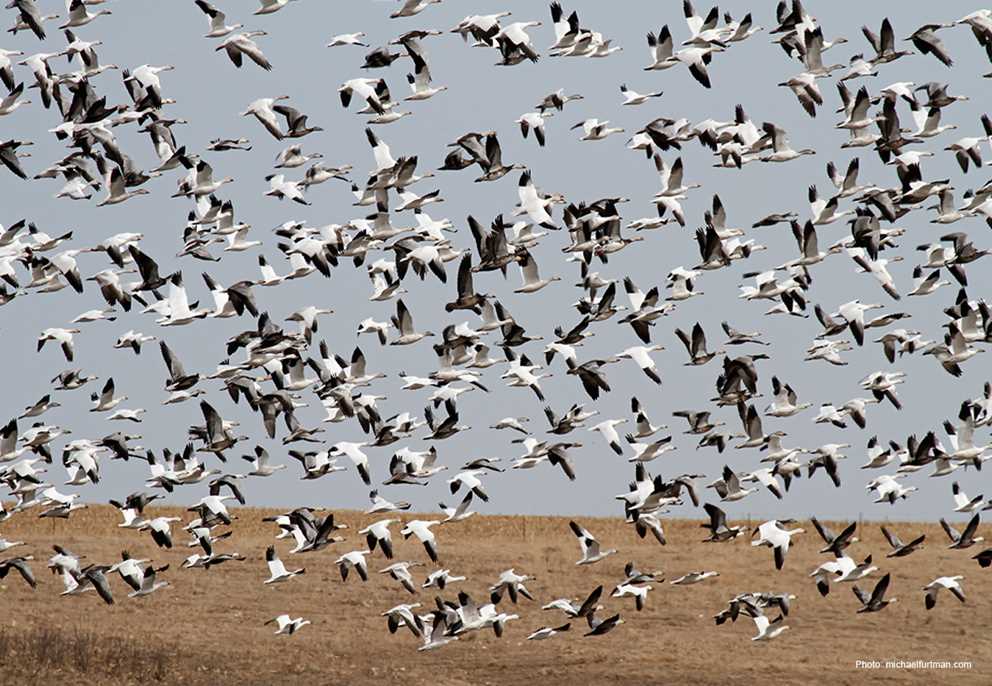Overview
The Snow Goose is among the most well studied waterfowl species, and among the most abundant species of waterfowl in the world. Its breeding range extends from Wrangel Island, Russia, across the Arctic coast and islands of northern Alaska and Canada to Greenland. Snow Geese winter exclusively in North America from Oregon and California east to the mid-Atlantic Coastal states, and south to northern Mexico. Two sub-species are recognized, the widely distributed, abundant Lesser Snow Goose (C. c. caerulescens) that occurs across most of central and western North America, and the Greater Snow Goose (C. c. atlantica) that occurs in eastern North America. Lesser Snow Geese winter primarily in the Central Valley of California, the Gulf Coast, and Mississippi Alluvial Valley but may be found in most areas where waterfowl winter. Greater Snow Geese winter on the mid-Atlantic coast from Massachusetts to North Carolina. Lesser Snow Geese have two color morphs, “white” and “blue,” with several intermediate phases, whereas Greater Snow Geese have only the “white” morph.
Adults of the light phase Lesser and all Greater Snow Geese are white, the primary coverts are gray, primary feathers are black, and they have rose red bills and feet, the bill showing the “grin patch” that separates the species from Ross’s Geese. Blue morph Lesser Snow Geese have white heads and necks, with the remainder of the body grayish brown, the wings show gray tinged with blue, the rump is gray, and the belly is grayish brown. Intermediate morphs show variable amounts of white on the belly and flanks. The bill and feet of the blue morph are like the white morph.
Snow Geese breed in large colonies in coastal Arctic areas that usually are at slightly higher elevation and clear of snow and ice earlier. Winter habitat historically was coastal marshes and some inland marshes that provided plants with preferred roots and rhizomes. Snow geese have subsequently adapted to agricultural habitats in migration and winter. They use a range of post-harvest waste grains (rice, corn, wheat, peas, barley) and graze leaves and grub for winter cereal roots (wheat, rye, barley). They gather to forage and roost in flocks at times numbering in the thousands to tens of thousands during migration and winter.
Description
Key Identification Features
- Snow Geese are medium-sized geese.
- The Lesser Snow Goose subspecies has two color morphs, white and blue. The Greater subspecies has only the white phase.
- The white phase is all white, except for gray primary coverts, and black primaries. The bill and feet are rose red, with the bill showing a notable “grin patch” that separates the species from the smaller but similar looking Ross’s Goose.
- The dark morph of the Lesser subspecies has a white head and neck, brown-gray body plumage, gray wing coverts tipped in blue with black primary feathers, and light gray belly, and gray rump. The bill and feet are like those of the light phase.
- Lesser Snow Geese have intermediate plumaged birds with characteristics of both color phases.
Male/Female Average Length and Weight
- Weight: Males are usually larger than females, and there is considerable variation and some overlap among subpopulations.
- Greater subspecies adult males 5.8–6.8 lbs.; adult females 5.1–5.7 lbs.
- Lesser subspecies adult males 4.2–6.2 lbs.; adult females 3.8–6.4 lbs.
- Wingspan: Males 16.1–17.2 in.; Females 14.9 in.
Male and Female Identification
- Alternate (Breeding) and Basic Plumage: The Lesser Snow Goose subspecies has two color morphs, white and blue. The Greater subspecies has only the white morph. The white phase is all white, except for gray primary coverts, and black primaries. The bill and feet are rose red, with the bill showing a notable “grin patch” that separates the species from the smaller but similar looking Ross’s Goose. The dark morph of the Lesser subspecies has a white head and neck, brown-gray body plumage, gray wing coverts tipped in blue with black primary feathers, and light gray belly, and gray rump. The bill and feet are like the light phase. Lesser Snow Geese have intermediate plumaged birds with characteristics of both color phases. Immature white phase birds are gray overall with grayish pink bills and feet, while immature blue morph birds have brown heads, neck, breast and flanks, white rumps and vents dark gray bills and feet.
In-flight Identification
- Snow Geese have black wing tips, as well as pink legs.
Vocalizations
- Very vocal, usually a loud, high pitched “kow-luk” or “whouk.”
Similar Species
- Ross’s Geese: Ross’s Geese are smaller and lack the grin patch on the bill. Blue morph Ross’s Geese are rare but may still be separated by size and lack of grin patch on the bill.
- Emperor Geese: Emperor Geese have a unique bicolor head and neck that separate them from blue morph Snow Geese.
Habitat Preferences
- Breeding: Snow Geese nest in Arctic coastal tundra habitats. Nest colonies occur in featureless, inland, slightly elevated areas first to clear of snow and ice in spring.
- Migration and Wintering: During migration and winter, Snow Geese historically used large coastal and inland marshes but have adapted to large scale agriculture and use rice, corn, wheat, barley, and pea fields, and pastures extensively. Roosts are large open wetlands, lakes or flooded agricultural fields.
Forging Habits and Diet
- Breeding Season: Snow Geese graze and grub a variety of vegetation. They feed entirely on vegetation. On breeding areas, they grub and graze a variety of plants, and in some locations can disrupt and change plant communities that have negative effects on other species of birds and wildlife.
- Migration and Winter: During migration and winter, they grub subterranean roots and rhizomes, graze green vegetation, and pick seeds of waste wheat, barley, rice, corn, and peas. They may occasionally cause damage in fields of winter cereal plants.
Breeding Habits
- Monogamy: Snow Geese maintain monogamous, lifelong pair bonds.
- Nest Locations: The nest is usually a scraped area with dead vegetation added as laying progresses and they are sometimes used in multiple years.
- Clutch Size: The average clutch size is 3–5 eggs. The eggs are creamy white, oval to sub-elliptical, and average 3.1 by 2.1 in. The incubation period is 24 days, with females performing incubation duties. Males provide nest defense
Migration and Distribution
- Fall Migration: Migration begins in late August, with most birds arriving on and staying in fall staging areas from September through November, depending on latitude and influenced by weather conditions. Arrival in wintering areas is from October to December.
- Spring Migration: In Spring, birds begin migration in February, arrive and stay in staging areas during March, April, and early May, and usually arrive on breeding areas in late May to June.

Conservation Status
- IUCN Status: Least Concern
- Population Status: The population of Snow Geese increased exponentially from 1970 (1 million birds) until 2013 (19 million birds) and has declined since that time to 14 million in 2019. The Mid-continent Population is estimated to contain about 83 percent of the total at 12 million birds. The Wrangel Island population is estimated at 440,000, while the Greater Snow Goose subspecies is estimated at 1.4 million birds.
- Conservation Concerns: No significant threats, most efforts aimed at reducing the high population level to mitigate impacts on other species of waterfowl, especially in Arctic areas.
- Conservation Focus: Managing burgeoning population through carefully increased hunting opportunities.
Harvest Information
Please note that these numbers are the result of combining Blue Goose and Snow Goose harvest data.
- An average of 309,623 Snow Geese were harvested per season across the US during the 2019 through 2022 hunting seasons.
- Snow Goose harvest is highest in the Pacific Flyway, accounting for 30 to 40 percent of the total US harvest.
- The top three states for Snow Goose harvest, based on annual averages across the 2019–2022 hunting seasons, were California (86,576), Texas (35,780), and Arkansas (20,787).




